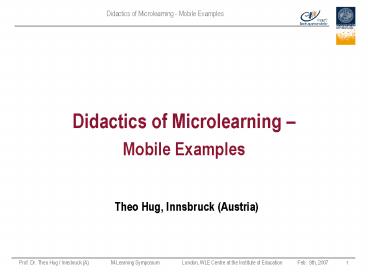Didactics of Microlearning Mobile Examples - PowerPoint PPT Presentation
1 / 14
Title:
Didactics of Microlearning Mobile Examples
Description:
Prof. Dr. Theo Hug / Innsbruck (A) M-Learning Symposium London, ... Microlearning Conceptual and ... video, podcasting and blogging technologies ... – PowerPoint PPT presentation
Number of Views:111
Avg rating:3.0/5.0
Title: Didactics of Microlearning Mobile Examples
1
Didactics of Microlearning Mobile Examples
- Theo Hug, Innsbruck (Austria)
2
Overview
- Points of Departure
- Paradoxes and Ambivalences
- Microlearning Conceptual and Didactical Aspects
- Mobile Examples Flocabulary, Vocabulary,
Historyand the Dr Who Principle - Conclusion
3
Points of Departure
- Common trends such as
- increasing technological investments
- digital divide policy
- fragmentation of knowledge (Instant Knowledge),
formats, audiences, life - Variety of Society-Descriptions Media
Generations - Mediatic Turn ?
4
Paradoxes and Ambivalences
- Europeanization and Internationalization of
education reform resistency - Economic performance justice of chances
- Commercialization of knowledge knowledge
obligation to the community - Trivialization of knowledge new forms,
structures and modalitites - Edutainment Media Education and Media Literacy
- Narration and Playful Identities (J. Raessens et
al, R. Leschke et al)
5
Microlearning
- deals with relatively small learning units and
short-term learning activities - relational concept depending on frames and
domains of reference - metaphorical characteristics - it works with
- a variety of learning concepts and models
- learning environments, arrangements, settings,
design patterns, didactical orientations, models
and concepts - A new paradigmatic perspective on learning
processes in mediated environments on micro
levels ?
6
Concepts and Versions of Microlearning
7
Mobile Examples 1 Flocabulary
- Bringing hip-hop music into high school
classrooms to teach SAT vocabulary and history
(M. Payne et al) - Rhythm and mnemonic rhymes
- URL www.flocabulary.com
8
Mobile Examples 2 Knowledge PulseTM (KP)
- Integrating small learning-activities in everyday
routines - Everyday Use of MediaUsing Gaps and Breaks in
Workflows and Multitasking - A Concept of Access Delays
Fig. 1 Daily routines Schematically
Figure 2 PC-workplace as example for Integrated
Microlearning
9
Characteristics
- push-approach
pull-approach - Concomitant learning
- open, flexible and modular but also
Learning Management - Embedded in workflow and daily life but
Knowledge Architecture - Short learning sequences are initiated according
to the use of media and the client settings - Small units are delivered automatically (push)
- So far The next step is put forward by a
Microstep Manager (slip box system, file-card
box)
10
Mobile Micro-Learning with the KP
So far, the information (false or right answers)
is processed by a special learning-algorithm
supporting the learning process (slip box
model). And from now on? How can we make use of
narrations and storytelling for educational
purposes in the context of micro-learning
arrangements?
11
Narration, Storytelling and Learning - Options
in the context of micro-learning arrangements
- Concepts of storytelling for didactical purposes
are widespread on the level of primary schools,
partly in second language learning as well (L2
learning). - Narrative Forms of Psychotherapy (e.g. M. White /
D. Epston 1993 K. P. Grossmann 2003) and
Elements of Hypno-Therapy (M. Erickson) and
Neuro-Linguistic Programming (NLP) (R. Bandler /
J. Grinder 1979) - New forms (e.g. online collaborative storytelling
platforms / blogs, narration and intermediality) - Exploring options in the context of
micro-learning arrangements - examples - Level 1 cartoon, caricature, elements of fabula
(scenes, events, key statements), one picture
story (single screens) - Level 2 sequences, arranged elements of fabula,
nested loops, comic strips (successions of
pictures, text-image combinations) - Level 3 storyline concept (J. Creswell 1997),
simulation globale (F. Debyser / J.-M. Caré
1984), (re-)framing and (re-)patterning
strategies, postmodern versions (e.g.
rhizomatic), narration discourse concept (S.J.
Schmidt 2004)
12
Mobile Examples 3 Episodic story-telling with
Albert
- An example of game-playing, narrative and
interactive learning content - Technology streaming video, podcasting and
blogging technologies - Gaming dimension conversation with Albert,
questions, challenges - Dr Who Principle (K. Newman R. Rigg
2007)learning content should, where appropriate
and feasible, be designed as episodic content
and delivered at appropriate time intervals
(ibd.) - URL www.bikingbear.com
Website for Albert in the Land of the Vikings
13
Mobile Examples 4 Frequency 1550
- Waag Society, a knowledge institute in Amsterdam
itwishes to make a contribution to the design
of the information society. In this it doesn't
let itself be lead by technology but instead
looks at the possibilities of people, their
creativity and culture. The interplay of
technology and culture is the driving force of
all Waag Society's activities (www.waag.org) - Frequency 1550, a pilot (2005) together with
the Amsterdam Montessori School - mobile game experience which fits with the
traditional curriculum (ibd.). - Learning results (J. Raessens, 2007)
- URL http//freq.1550.waag.org
Frequency 1550, February 10 2005
14
Didactics of Microlearning Conclusion
- Making use of the use of media for educational
purposes - Limits of utilization of game-based approaches,
playful identities and ludic cultures? - Topography of micro-structures and its relation
to media dynamics - Descriptions of new forms of managing didactical
complexity and contingency - The narration of microlearning has no end in
itself it offers new ways of bridging informal
and (non-)formal learning in a mediated world































